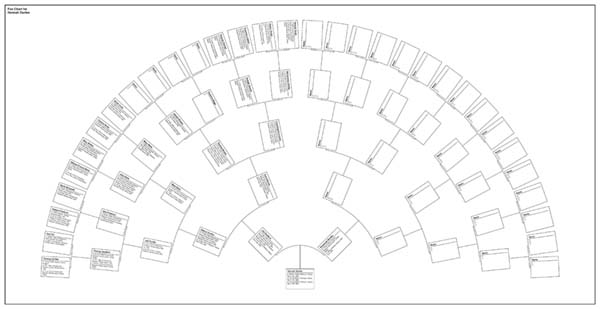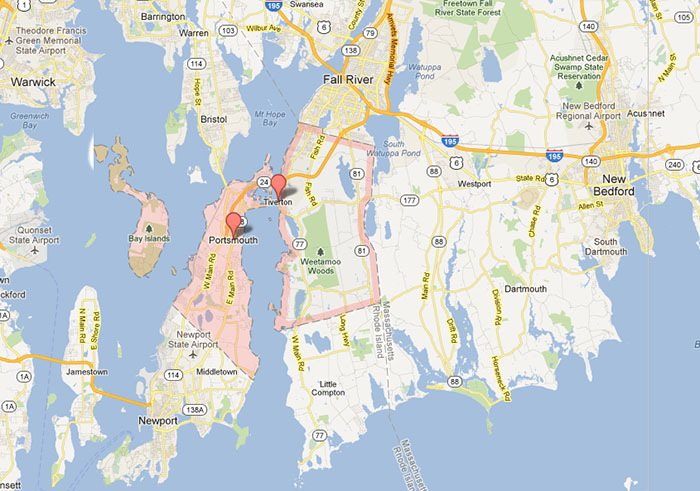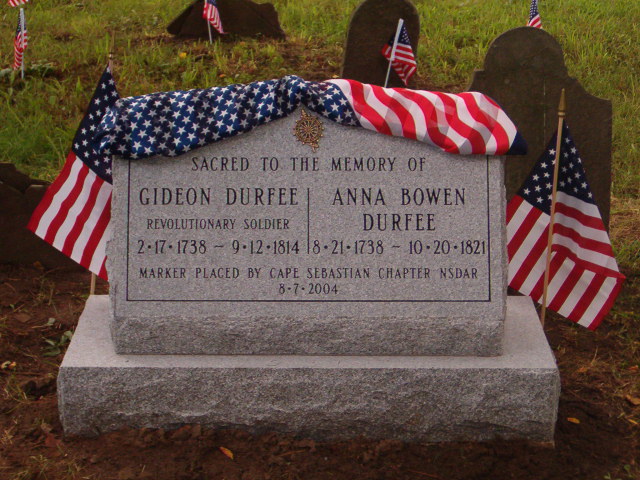|
The Durfee Line As may be seen from the fan chart just above, half the Durfee ancestors are missing, thanks to there being no record of Susannah Borden's parents. Concentrating on the male Durfee line, however, we begin with the family's original immigrant, Thomas Durfee (1643-1712), who arrived in New England in 1660. Information about Thomas and his descendants have been drawn from a number of resources, but it is worth noting that William F. Reed wrote a book published in 1902 entitled The Descendants of Thomas Durfee of Portsmouth, R.I. (hereafter "Descendants,") which -- subject to the vagaries of 19th century genealogical research -- covers all the Durfee descendants, including our own line down to and including Hannah Durfee, who married John Fran. Sickels. The book -- available in full text as a Google-scanned book -- presents another of those microcosms of American Colonial history. Much of the history I provide below comes from that book. After Thomas, our line includes Thomas Durfee II (1669-1729), Job Durfee (1710-1774), Gideon Durfee (1738-1814), Job Durfee II (1763-1813), and Hannah Durfee (1796-1827). The Durfee name has been traced in England only three generations prior to immigrant Thomas, to a Job Durfey born in 1560. (One must wonder about a family in which the name "Job" figures so prominently -- four times in our line, plus Job Durfee Sickels; ten Job Durfees listed on Ancestry.com -- did they witness or foresee some special degree of suffering?) Descendants seeks origin of the name "Durfee" and makes a persuasive argument that it is an Anglicization of the French, "d'Urfe," a family with a prominent and frequent role in French Medieval history -- one source says they were probably French Huguenot, which might explain their move to England. (There is even a coat of arms.) See also this article.
As noted, Thomas Durfee
arrived in 1660 (Descendants says prior to 1664). He
may have arrived as a "redemptioner," which means he did not prepay
his trans-Atlantic passage but was sold "by auction for the lowest
term of years for which anyone would take them and pay the passage
money." He may have served his time in the household of
Peter Tallman (see below), where he first would have met his future
wife, Ann (Hill) Tallman. He became a freeman in Portsmouth, RI, in 1673.
The following descriptions of his activities in Portsmouth come
from Descendants:
Descendants fails to note something of slightly more salacious nature (possibly to avoid offending Victorian sensitivities):
This was the same Peter Tallman who later sold Thomas some land in 1683. The plot thickens. Thomas did marry Tallman's ex-wife, Ann Hill, who had been married to Tallman for sixteen years and became Thomas's first wife (his second, mentioned in the Will above, was Deliverance Hall.) Not only that, but Thomas's daughter Patience (by his second wife, Deliverance) married Benjamin Tallman, Peter's son, albeit fortunately by his second wife. Nevertheless, there's a slight whiff of Peyton Place in 17th century Portsmouth. Durfee's eldest son Robert, born in March 1665, was probably his by Ann while she was still married to Tallman. See also this extensive discussion of Ann (Hill) (Tallman) Durfee, Thomas Durfee, and the history of their relationship. Thomas Durfee II was born in 1669, in Portsmouth, RI. Descendants discusses his wife, Ann Freeborn, and her family at length, as they were prominent in early Rhode Island history. Ann's grandfather had been expelled from Massachusetts along with Roger Williams, for unacceptable religious beliefs. Thus, those of us descending from the Durfees may claim part of the American heritage that led in time to the First Amendment's guarantees of religious freedom and separation of church and state. (Descendants, pp. 24-25.) (Anne's father was Gideon Freeborn (1639-1720). Gideon's great-granddaughter Susannah Freeborn (1755-1829) married Gideon Durfee (1755-1828), who was also Gideon's great-grandson because of his daughter Anne's marriage to Thomas Durfee II -- Gideon (1755-1828), son of Job (1733-1810), son of Gideon (1704-1766), son of Thomas II. Just another example in our lineage of families combining, separating, and then recombining.) Thomas II was a member of the Rhode Island General Assembly in 1707, 1709 and 1713.
References to Thomas Durfee
II in Descendants (otherwise nothing of significance found in
my research):
As noted in the Will, Job Durfee was considered a minor at the time his father died, although he was eighteen (Thomas prepared his will only 1-1/2 months before his death). Job became a freeman of Portsmouth in May 1731. He bought land (from Joseph Cook, lot No. 19 in the six score acre lots on Stafford Road, Tiverton) and built a house which was still standing in 1916 and had been lived in by descendants at least until then. He was deputy to the Rhode Island General Assembly in 1761, 1762 and 1764.
Above is a late 19th century photograph of the house Job built in Tiverton. You can see relationship of Portsmouth and Tiverton on this map:
Of Job Descendants has this:
Two notes regarding the Will: first, it shows a considerable increase in property in only three generations in Portsmouth, RI; and, second, Job was still a slave owner, although he decreed, "I will and order that my negro man named Dominie, be a free man Immediately after my Decease." Finally, after three generations, this abhorrent practice came to an end within the Durfee family.
(Read the entire article -- it will be time well-spent in expanding your appreciation of the largely unappreciated subject of slavery in the North.) (Yet another Job Durfee, this one my 2d cousin, 5x removed, gained some fame as a jurist in Rhode Island -- after a political career which included a couple of terms in the U.S. House of Representatives, he became first an associate justice and then -- 1835-1847 -- chief justice of the Rhode Island Supreme Court. From Wikipedia: "As chief justice, he presided over the trial of the last person executed in Rhode Island, John Gordon.") Job's third child, Gideon, is shown on Revolutionary War rolls as a Private in Col. Christopher Olney's Rhode Island Regiment, from October 8 to November 7, 1781, which is confirmed by the DAR database. According to the DAR, he served in the Tiverton Alarm, explained thus:
To paraphrase another source: This month's service with no enemy in sight makes Gideon a Revolutionary War soldier, and entitles his descendants to join the SAR or DAR. Thus, cheaply was the honor earned by many of those descendants who pride themselves on the patriotism of their ancestors. However, the dates of his service (in 1781) don't appear to match the dates of the Tiverton Alarm (1780). More detail is found in Descendants:
Other sources:
Job Durfee II was the last of our Durfees born in Tiverton, Rhode Island. He followed his father, Gideon, to Palmyra, apparently shortly after Gideon's initial trip there. The only thing found in Descendants reads: "Mr. Durfee came from Tiverton, R.I., to Palmyra, N.Y., in 1791, and purchased, March 7, 1792, 300 acres of land, at 75 cents per acre." Interestingly, one of Job's brothers, Lemuel (1759-1829), had business dealings with Joseph Smith, founder of the Mormon Church:
That was two years after the Mormon Church founder was first directed to the location of the golden plates that play such a central role in Mormon mythology. Another source: "The plates of the Mormon Bible were said to have been dug up on a hillside in Manchester, Ontario Co., a little S. of the Palmyra line. The Smiths were money diggers, and had previously been digging in this locality for gold." Job's daughter Hannah Durfee merits no mention in Descendants. She of course married John Fran. Sickels and was Job Durfee Sickels's mother. Finally, see the map at "The Allure of Western New York" for a record of the concentration of my families' ancestors in the 19th century. [Return to Hannah Amanda Sickels] |
||||||||||||||||||||||||||||


